Rafael Pires
Accelerating MoE Model Inference with Expert Sharding
Mar 11, 2025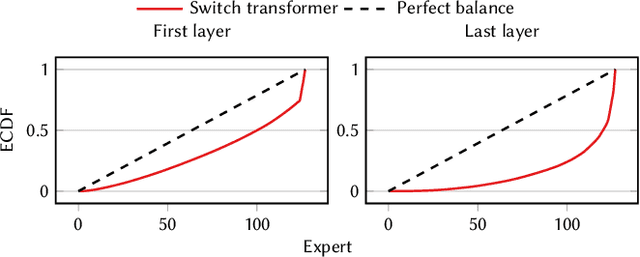

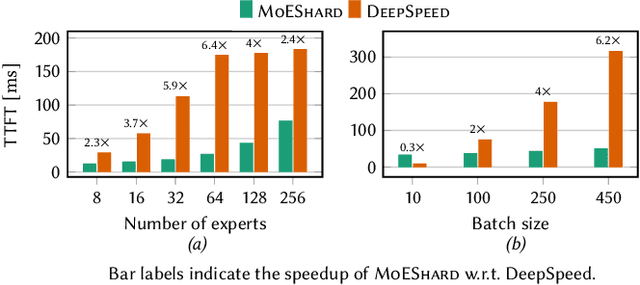
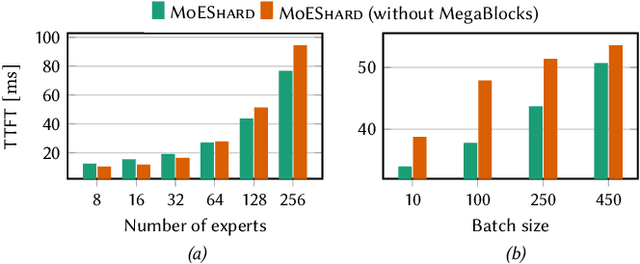
Abstract:Mixture of experts (MoE) models achieve state-of-the-art results in language modeling but suffer from inefficient hardware utilization due to imbalanced token routing and communication overhead. While prior work has focused on optimizing MoE training and decoder architectures, inference for encoder-based MoE models in a multi-GPU with expert parallelism setting remains underexplored. We introduce MoEShard, an inference system that achieves perfect load balancing through tensor sharding of MoE experts. Unlike existing approaches that rely on heuristic capacity factors or drop tokens, MoEShard evenly distributes computation across GPUs and ensures full token retention, maximizing utilization regardless of routing skewness. We achieve this through a strategic row- and column-wise decomposition of expert matrices. This reduces idle time and avoids bottlenecks caused by imbalanced expert assignments. Furthermore, MoEShard minimizes kernel launches by fusing decomposed expert computations, significantly improving throughput. We evaluate MoEShard against DeepSpeed on encoder-based architectures, demonstrating speedups of up to 6.4$\times$ in time to first token (TTFT). Our results show that tensor sharding, when properly applied to experts, is a viable and effective strategy for efficient MoE inference.
Leveraging Approximate Caching for Faster Retrieval-Augmented Generation
Mar 07, 2025Abstract:Retrieval-augmented generation (RAG) enhances the reliability of large language model (LLM) answers by integrating external knowledge. However, RAG increases the end-to-end inference time since looking for relevant documents from large vector databases is computationally expensive. To address this, we introduce Proximity, an approximate key-value cache that optimizes the RAG workflow by leveraging similarities in user queries. Instead of treating each query independently, Proximity reuses previously retrieved documents when similar queries appear, reducing reliance on expensive vector database lookups. We evaluate Proximity on the MMLU and MedRAG benchmarks, demonstrating that it significantly improves retrieval efficiency while maintaining response accuracy. Proximity reduces retrieval latency by up to 59% while maintaining accuracy and lowers the computational burden on the vector database. We also experiment with different similarity thresholds and quantify the trade-off between speed and recall. Our work shows that approximate caching is a viable and effective strategy for optimizing RAG-based systems.
Efficient Federated Search for Retrieval-Augmented Generation
Feb 26, 2025Abstract:Large language models (LLMs) have demonstrated remarkable capabilities across various domains but remain susceptible to hallucinations and inconsistencies, limiting their reliability. Retrieval-augmented generation (RAG) mitigates these issues by grounding model responses in external knowledge sources. Existing RAG workflows often leverage a single vector database, which is impractical in the common setting where information is distributed across multiple repositories. We introduce RAGRoute, a novel mechanism for federated RAG search. RAGRoute dynamically selects relevant data sources at query time using a lightweight neural network classifier. By not querying every data source, this approach significantly reduces query overhead, improves retrieval efficiency, and minimizes the retrieval of irrelevant information. We evaluate RAGRoute using the MIRAGE and MMLU benchmarks and demonstrate its effectiveness in retrieving relevant documents while reducing the number of queries. RAGRoute reduces the total number of queries up to 77.5% and communication volume up to 76.2%.
Revisiting Ensembling in One-Shot Federated Learning
Nov 11, 2024
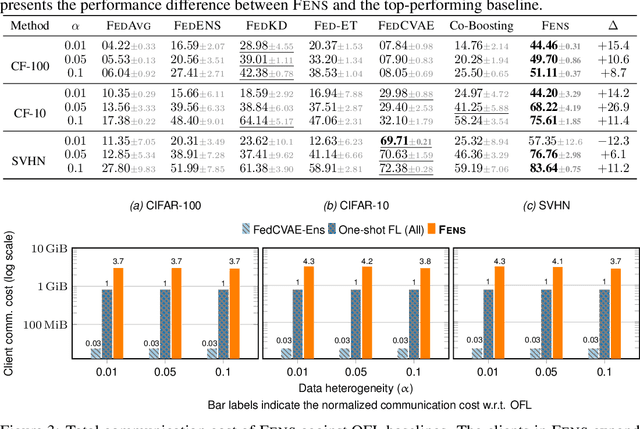
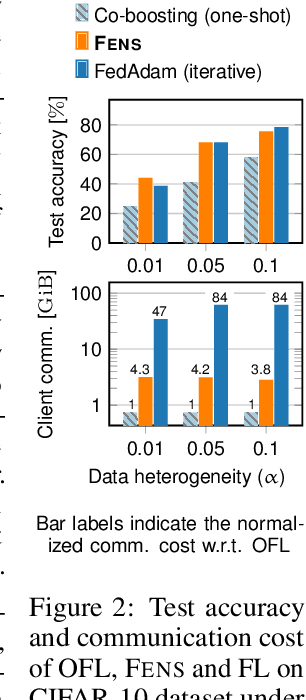

Abstract:Federated learning (FL) is an appealing approach to training machine learning models without sharing raw data. However, standard FL algorithms are iterative and thus induce a significant communication cost. One-shot federated learning (OFL) trades the iterative exchange of models between clients and the server with a single round of communication, thereby saving substantially on communication costs. Not surprisingly, OFL exhibits a performance gap in terms of accuracy with respect to FL, especially under high data heterogeneity. We introduce FENS, a novel federated ensembling scheme that approaches the accuracy of FL with the communication efficiency of OFL. Learning in FENS proceeds in two phases: first, clients train models locally and send them to the server, similar to OFL; second, clients collaboratively train a lightweight prediction aggregator model using FL. We showcase the effectiveness of FENS through exhaustive experiments spanning several datasets and heterogeneity levels. In the particular case of heterogeneously distributed CIFAR-10 dataset, FENS achieves up to a 26.9% higher accuracy over state-of-the-art (SOTA) OFL, being only 3.1% lower than FL. At the same time, FENS incurs at most 4.3x more communication than OFL, whereas FL is at least 10.9x more communication-intensive than FENS.
Boosting Asynchronous Decentralized Learning with Model Fragmentation
Oct 16, 2024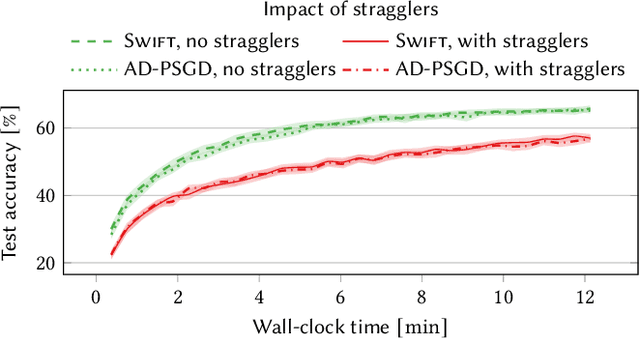


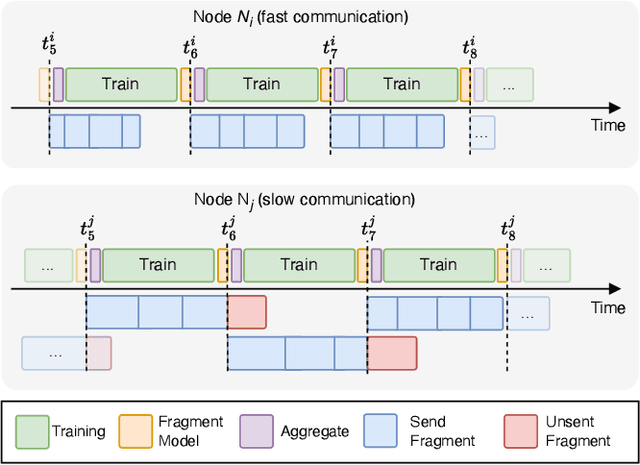
Abstract:Decentralized learning (DL) is an emerging technique that allows nodes on the web to collaboratively train machine learning models without sharing raw data. Dealing with stragglers, i.e., nodes with slower compute or communication than others, is a key challenge in DL. We present DivShare, a novel asynchronous DL algorithm that achieves fast model convergence in the presence of communication stragglers. DivShare achieves this by having nodes fragment their models into parameter subsets and send, in parallel to computation, each subset to a random sample of other nodes instead of sequentially exchanging full models. The transfer of smaller fragments allows more efficient usage of the collective bandwidth and enables nodes with slow network links to quickly contribute with at least some of their model parameters. By theoretically proving the convergence of DivShare, we provide, to the best of our knowledge, the first formal proof of convergence for a DL algorithm that accounts for the effects of asynchronous communication with delays. We experimentally evaluate DivShare against two state-of-the-art DL baselines, AD-PSGD and Swift, and with two standard datasets, CIFAR-10 and MovieLens. We find that DivShare with communication stragglers lowers time-to-accuracy by up to 3.9x compared to AD-PSGD on the CIFAR-10 dataset. Compared to baselines, DivShare also achieves up to 19.4% better accuracy and 9.5% lower test loss on the CIFAR-10 and MovieLens datasets, respectively.
Energy-Aware Decentralized Learning with Intermittent Model Training
Jul 01, 2024



Abstract:Decentralized learning (DL) offers a powerful framework where nodes collaboratively train models without sharing raw data and without the coordination of a central server. In the iterative rounds of DL, models are trained locally, shared with neighbors in the topology, and aggregated with other models received from neighbors. Sharing and merging models contribute to convergence towards a consensus model that generalizes better across the collective data captured at training time. In addition, the energy consumption while sharing and merging model parameters is negligible compared to the energy spent during the training phase. Leveraging this fact, we present SkipTrain, a novel DL algorithm, which minimizes energy consumption in decentralized learning by strategically skipping some training rounds and substituting them with synchronization rounds. These training-silent periods, besides saving energy, also allow models to better mix and finally produce models with superior accuracy than typical DL algorithms that train at every round. Our empirical evaluations with 256 nodes demonstrate that SkipTrain reduces energy consumption by 50% and increases model accuracy by up to 12% compared to D-PSGD, the conventional DL algorithm.
Harnessing Increased Client Participation with Cohort-Parallel Federated Learning
May 24, 2024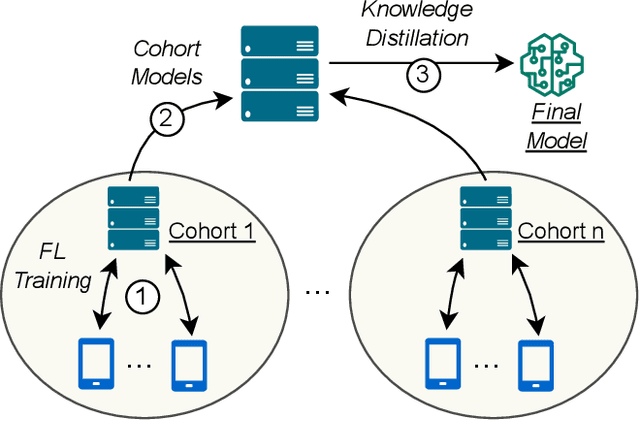
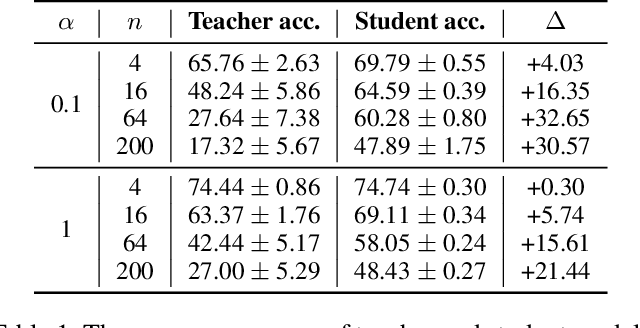
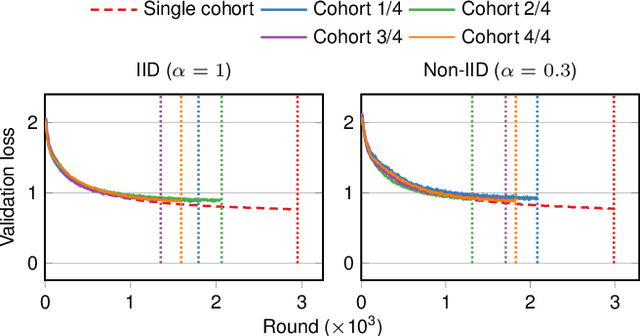

Abstract:Federated Learning (FL) is a machine learning approach where nodes collaboratively train a global model. As more nodes participate in a round of FL, the effectiveness of individual model updates by nodes also diminishes. In this study, we increase the effectiveness of client updates by dividing the network into smaller partitions, or cohorts. We introduce Cohort-Parallel Federated Learning (CPFL): a novel learning approach where each cohort independently trains a global model using FL, until convergence, and the produced models by each cohort are then unified using one-shot Knowledge Distillation (KD) and a cross-domain, unlabeled dataset. The insight behind CPFL is that smaller, isolated networks converge quicker than in a one-network setting where all nodes participate. Through exhaustive experiments involving realistic traces and non-IID data distributions on the CIFAR-10 and FEMNIST image classification tasks, we investigate the balance between the number of cohorts, model accuracy, training time, and compute and communication resources. Compared to traditional FL, CPFL with four cohorts, non-IID data distribution, and CIFAR-10 yields a 1.9$\times$ reduction in train time and a 1.3$\times$ reduction in resource usage, with a minimal drop in test accuracy.
Secure Aggregation Meets Sparsification in Decentralized Learning
May 14, 2024Abstract:Decentralized learning (DL) faces increased vulnerability to privacy breaches due to sophisticated attacks on machine learning (ML) models. Secure aggregation is a computationally efficient cryptographic technique that enables multiple parties to compute an aggregate of their private data while keeping their individual inputs concealed from each other and from any central aggregator. To enhance communication efficiency in DL, sparsification techniques are used, selectively sharing only the most crucial parameters or gradients in a model, thereby maintaining efficiency without notably compromising accuracy. However, applying secure aggregation to sparsified models in DL is challenging due to the transmission of disjoint parameter sets by distinct nodes, which can prevent masks from canceling out effectively. This paper introduces CESAR, a novel secure aggregation protocol for DL designed to be compatible with existing sparsification mechanisms. CESAR provably defends against honest-but-curious adversaries and can be formally adapted to counteract collusion between them. We provide a foundational understanding of the interaction between the sparsification carried out by the nodes and the proportion of the parameters shared under CESAR in both colluding and non-colluding environments, offering analytical insight into the working and applicability of the protocol. Experiments on a network with 48 nodes in a 3-regular topology show that with random subsampling, CESAR is always within 0.5% accuracy of decentralized parallel stochastic gradient descent (D-PSGD), while adding only 11% of data overhead. Moreover, it surpasses the accuracy on TopK by up to 0.3% on independent and identically distributed (IID) data.
Beyond Noise: Privacy-Preserving Decentralized Learning with Virtual Nodes
Apr 15, 2024Abstract:Decentralized learning (DL) enables collaborative learning without a server and without training data leaving the users' devices. However, the models shared in DL can still be used to infer training data. Conventional privacy defenses such as differential privacy and secure aggregation fall short in effectively safeguarding user privacy in DL. We introduce Shatter, a novel DL approach in which nodes create virtual nodes (VNs) to disseminate chunks of their full model on their behalf. This enhances privacy by (i) preventing attackers from collecting full models from other nodes, and (ii) hiding the identity of the original node that produced a given model chunk. We theoretically prove the convergence of Shatter and provide a formal analysis demonstrating how Shatter reduces the efficacy of attacks compared to when exchanging full models between participating nodes. We evaluate the convergence and attack resilience of Shatter with existing DL algorithms, with heterogeneous datasets, and against three standard privacy attacks, including gradient inversion. Our evaluation shows that Shatter not only renders these privacy attacks infeasible when each node operates 16 VNs but also exhibits a positive impact on model convergence compared to standard DL. This enhanced privacy comes with a manageable increase in communication volume.
Low-Cost Privacy-Aware Decentralized Learning
Mar 18, 2024
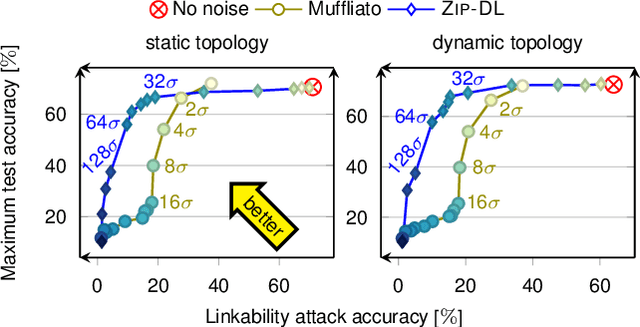
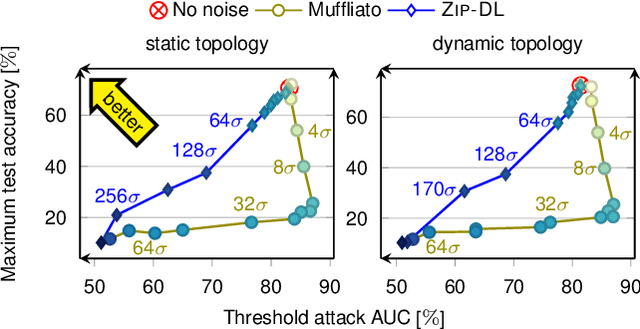
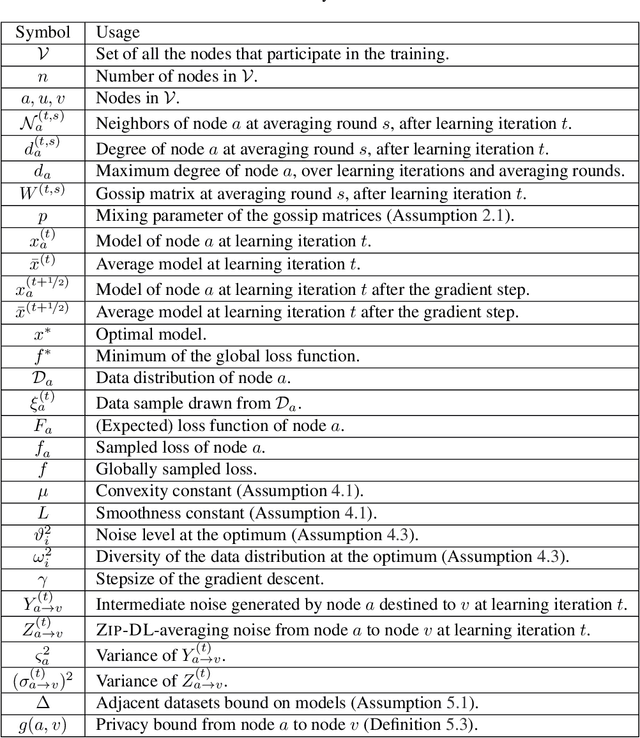
Abstract:This paper introduces ZIP-DL, a novel privacy-aware decentralized learning (DL) algorithm that relies on adding correlated noise to each model update during the model training process. This technique ensures that the added noise almost neutralizes itself during the aggregation process due to its correlation, thus minimizing the impact on model accuracy. In addition, ZIP-DL does not require multiple communication rounds for noise cancellation, addressing the common trade-off between privacy protection and communication overhead. We provide theoretical guarantees for both convergence speed and privacy guarantees, thereby making ZIP-DL applicable to practical scenarios. Our extensive experimental study shows that ZIP-DL achieves the best trade-off between vulnerability and accuracy. In particular, ZIP-DL (i) reduces the effectiveness of a linkability attack by up to 52 points compared to baseline DL, and (ii) achieves up to 37 more accuracy points for the same vulnerability under membership inference attacks against a privacy-preserving competitor
 Add to Chrome
Add to Chrome Add to Firefox
Add to Firefox Add to Edge
Add to Edge